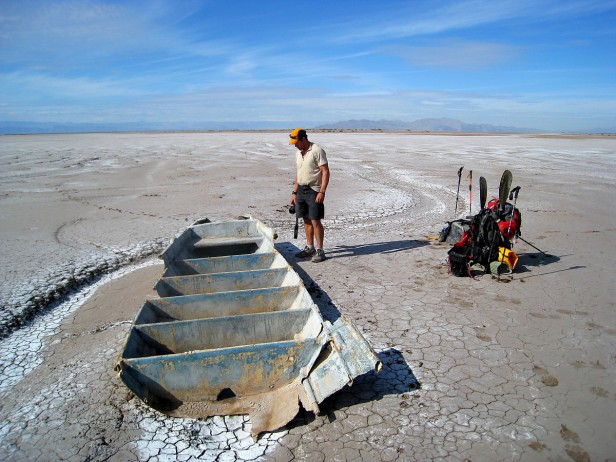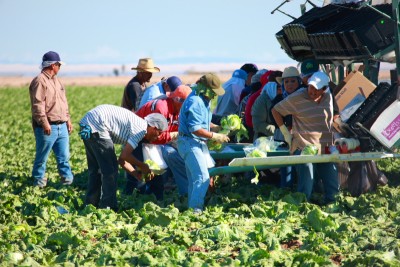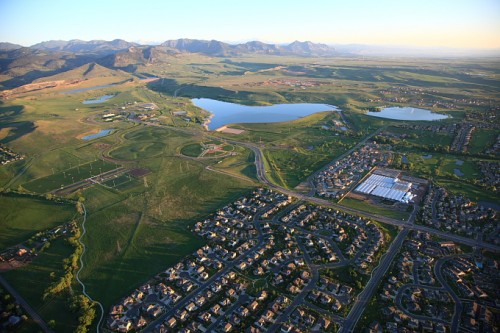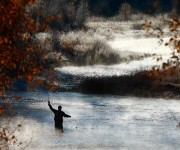 Jonathan Waterman is the author of the book Running Dry about the Colorado River. Waterman, who infected his feet in the polluted remains of the drying river, walked with the photographer Pete McBride down the last 60 miles of delta. The once rich estuary and its wetlands have been reduced by 95 percent since dam construction. The river has not reached the Sea of Cortez for more than a decade, with the exception of several days of rare flooding combined with cancelled farm orders. Still, conservationists on either side of the border are working to bring pulse flows to the delta and restore a river, along with a once beautiful estuary — lost to the farms and cities upstream. The following is the second of two excerpts from the book.
Jonathan Waterman is the author of the book Running Dry about the Colorado River. Waterman, who infected his feet in the polluted remains of the drying river, walked with the photographer Pete McBride down the last 60 miles of delta. The once rich estuary and its wetlands have been reduced by 95 percent since dam construction. The river has not reached the Sea of Cortez for more than a decade, with the exception of several days of rare flooding combined with cancelled farm orders. Still, conservationists on either side of the border are working to bring pulse flows to the delta and restore a river, along with a once beautiful estuary — lost to the farms and cities upstream. The following is the second of two excerpts from the book.
 Pete McBride next to an abandoned fishing boat on the dried up Colorado River delta in Mexico.Photo courtesy of Jonathan Waterman
Pete McBride next to an abandoned fishing boat on the dried up Colorado River delta in Mexico.Photo courtesy of Jonathan Waterman
We move southwest, averaging 15 miles a day, stringing together irrigation canals that vaguely point toward the Gulf of California. Half of the time, we’re lost in the dried-out maze of riverbeds cut by farm fields, canals, roads, and railroad tracks. Pete flags down a pickup truck and asks for directions. They contradict the last set of directions.
This man, Jorge, a ditch inspector, is driving a brand-new Ford. He gives us his business card and insists that we call him if we need help. In Spanish he tells us: “I like American adventurers! Mexicans just sit around and eat beans and say ‘manana!'” We shake our heads, but because he’s laughing, we laugh with him.
A low flying crop-duster plane bisects our path, followed by a troop of snowy egrets, buzzing directly over us on another narrowing canal. Burrowing owls cum jack-in-the-boxes pop their heads in and out of nest holes along the canal. I see my first avocet of the entire trip: black and long beaked to match its legs, like an avian clown.
On our third night out, we camp in an alfalfa field along an irrigation canal thickly layered in duckweed, its crumbling cement walls coated in brown slime. I cook freeze-dried chili on the stove with our last two gallons of water. Dinner conversation is a series of grunts, owing to a day of strong-armed paddling through thick, stilled gunk.
My sleeping pads puncture when I lie down on a hidden strand of barbed wire. As Pete snoozes in comfort atop his two pads, I make my bed in the agricultural product that drinks more water than any Colorado River crop: hay. In the silence surrounding midnight, a local farm dog catches our scent and, in a frenzy of barking, charges across the field to attack. Ten yards from the tent, I give him my best dog whispering voice: “Bad boy, go home.” And it works.
In the morning, we debate our whereabouts on the latest 1:250,000-scale map, but it seems that this shifting, dried-out monster of a delta has defied its cartographers. So we consult a GPS downloaded with larger-scale Mexican maps. I carry it in my hand like a border patrolman clutching a radio. Although the two-inch screen shows us as a blinking triangle amid the vast sweep of Colorado River, the GPS omits the roads and irrigation canals that we’ve been crossing. So we continue steering through frequent polls of passing Mexicans and constant east-west route corrections. On the strength of the GPS finally matching up with a piece of landscape, we walk away from all roads and farmlands down a deep river channel, filled only with sand and tamarisk. Coyote tracks dent the river bottom, and stillness comes over the cottonwood forests as we plunge deeper into no-man’s-land. According to our small-scale map of the delta, we’re walking down a Rio Colorado channel that should dump us into the still active tributary, Rio Hardy. By now my feet are swollen with white blisters oozing clear fluids and wetting my socks. The last few months of sitting in boats with sandals has splayed my feet into fat, lazy appendages unaccustomed to shoes. So I have taped on moleskin, cut with holes to take pressure off the bulging blisters. With frequent doses of anti-inflammatory ibuprofen to cool each fiery footstep, my feet should carry me to the Río Hardy, where we can sit down and begin paddling again.
 The largest diversion on all the river is to California’s Imperial Valley, the source of America’s winter lettuce.Photo courtesy of Jonathan WatermanOur tongues are sticking to our cotton-dry mouths. Our packs are light, empty of water.
The largest diversion on all the river is to California’s Imperial Valley, the source of America’s winter lettuce.Photo courtesy of Jonathan WatermanOur tongues are sticking to our cotton-dry mouths. Our packs are light, empty of water.
Several miles down the wild, dried-out channel, we find a cement-mortared well, dug into whatever circulatory dribble might exist below the riverbed. After introducing ourselves to the well owner up on the bank, we find Carlos strangely tentative and wary about two strangers walking onto his remote plantation. But we know that he knows that we’re harmless gringos. So we attribute his cool air to shyness.
As we stand over the well, he says that it took him 10 days of shoveling until he hit water 45 feet down. His body is as sinewy and straight as a stalk of giant cane.
We ask him if it’s okay to take a drink. “Okay,” he replies. We lower the bucket, then wind it back up. Pete hands the first cup to me, the team guinea pig. I spit the alkaline liquid out immediately. Even if I could gag it down, my lower intestine would be limed white as the walls of Carlos’s well. “Gracias,” I say to him, “no me gusta Río Colorado agua.” Pete tells Carlos that we’ve come so that I can make it all 1,450 miles from the headwaters to the sea. “¿Media loco?” Pete asks him about my plan. “No es media loco,” Carlos replies, “Es muy loco.” Pete and I laugh, but Carlos stands sullen and sulking.
Carlos is growing watermelons, he tells us.
 Colorado River water is sent east under the Rockies through 12 different tunnels to supply the growing cities surrounding Denver.Photo courtesy of Jonathan Waterman“Watermelons?” asks Pete, astonished. Carlos nods and then quickly changes the subject to say that we better look out for narcotraficantes farther down the river.
Colorado River water is sent east under the Rockies through 12 different tunnels to supply the growing cities surrounding Denver.Photo courtesy of Jonathan Waterman“Watermelons?” asks Pete, astonished. Carlos nods and then quickly changes the subject to say that we better look out for narcotraficantes farther down the river.
Under his grass-roofed palapala above the river, we offer to pay him for real drinking water. Carlos may be standoffish, but because he’s a Mexican at heart, he refuses our money and uses his market-filled jug to refill our empty bag. After a long discussion over our map, he convinces us to leave the south-trending riverbed and walk the road west toward the Río Hardy. There’s no reason not to trust his directions. Our meeting is an instance of the time-honored linkage of strangers amid the wilderness. We shake his hand in appreciation and, as we lift up our despised packs, he once again warns us about narcotraficantes en el Río Colorado.
“¿Es verdad?” Pete asks.
Carlos shakes his head and replies that it’s true, we’ll get our asses shot off if we’re not careful. We wave good-bye. As we win
d our way through a labyrinth of obscure sand roads toward an equally obscure stony road west, we realize that our well-digging friend has deliberately tucked himself quite deep in the wilds.
Hobbling west, on a road graded in large, sharp stones that jab my raw feet with every red-hot step, I ask Pete if he believes Carlos about the drug runners. Pete replies: “And you think he’s really growing watermelons?”



